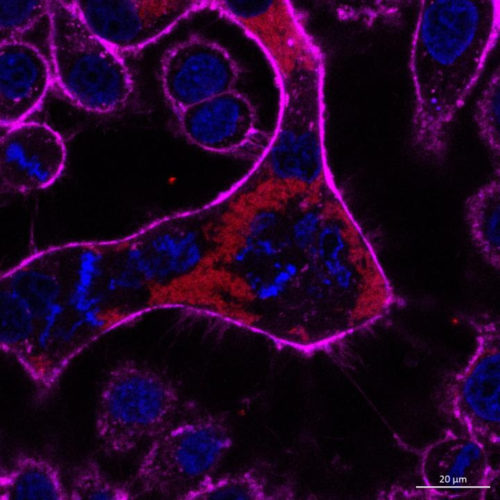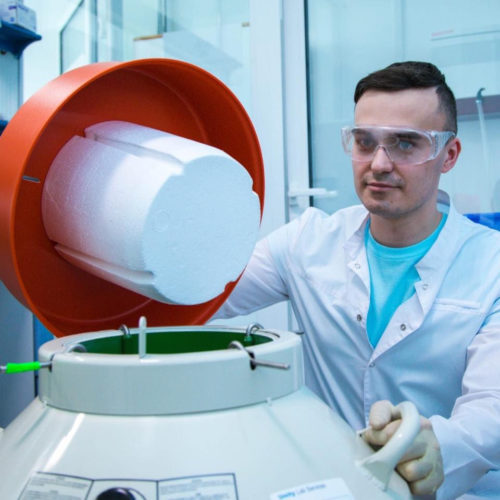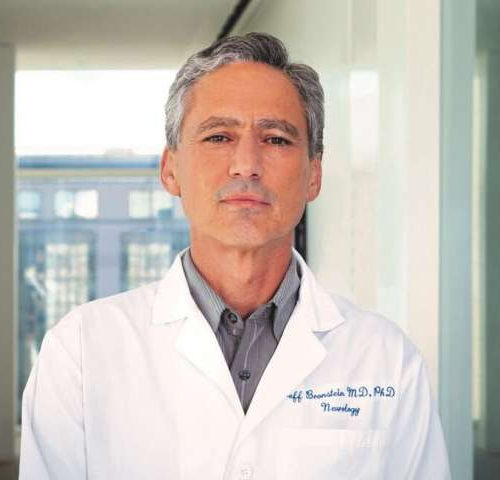NATIONAL UNIVERSITY OF SINGAPORE, YONG LOO LIN SCHOOL OF MEDICINE A GIANT CELL RESULTING FROM BURKHOLDERIA INFECTION UNDERGOING ABORTIVE CELL DIVISION. PART 1: THE GENETIC MATERIAL IN THE GIANT CELL IS HIGHLY CONDENSED, SIMILAR TO WHAT HAPPENS DURING NORMAL CELL… view more CREDIT: DR GAN YUNN HWEN Burkholderia pseudomallei is a bacterium in the soil...
Tag: <span>autophagy</span>
Osmotic stress identified as stimulator of cellular waste disposal
IMAGE OF MOUSE ASTROCYTES SHOWING THE ACTIN CYTOSKELETON (RED) AND LYSOSOMES (GREEN) view more CREDIT: TANIA LOPEZ-HERNANDEZ Cellular waste disposal, where autophagy and lysosomes interact, performs elementary functions, such as degrading damaged protein molecules, which impair cellular function, and reintroducing the resulting building blocks such as amino acids into the metabolic system. This recycling process...
Scientists found out how nanoparticles kill cancer cells
In the authors’ opinion, this research will help to treat oncology IMMANUEL KANT BALTIC FEDERAL UNIVERSITY CREDIT: IMMANUEL KANT BALTIC FEDERAL UNIVERSITY Scientists from the Immanuel Kant Baltic Federal University (IKBFU) and National University of Science and Technology “MISiS” have studied how magnet nanoparticles affect cancer cells in the human liver. In the authors’ opinion,...
Scientists find evidence of link between diesel exhaust, risk of Parkinson’s
by Caroline Seydel, University of California, Los Angeles A new UCLA study in zebrafish has identified the process by which air pollution can damage brain cells, potentially contributing to Parkinson’s disease. Published in the peer-reviewed journal Toxicological Sciences, the findings show that chemicals in diesel exhaust can trigger the toxic buildup of a protein in...
Pancreatic cancer hidden in plain sight
Pancreatic cancer does not respond to certain anticancer treatments that boost immune responses. A mechanism active in tumour cells that contributes to this evasion of immune targeting has been uncovered. A consistent hallmark of pancreatic cancer is the inability to treat it with immunotherapy — an approach that harnesses the body’s immune response to target...
A billion years of evolution suggests a new approach for Alzheimer’s disease treatment
by Royal Holloway, University of London Credit: CC0 Public Domain New research by academics at Royal Holloway, University of London, urges scientists that are looking to finding a cure for Alzheimer’s disease to focus on the role of proteins in the brain that cause Alzheimer’s disease. This change in focus could enable the development of new treatments. It...
In surprising reversal, scientists find a cellular process that stops cancer before it starts
Just as plastic tips protect the ends of shoelaces and keep them from fraying when we tie them, molecular tips called telomeres protect the ends of chromosomes and keep them from fusing when cells continually divide and duplicate their DNA. But while losing the plastic tips may lead to messy laces, telomere loss may lead...
HKUST scientists discover autophagy inhibitory peptides from giant ankyrins
HONG KONG UNIVERSITY OF SCIENCE AND TECHNOLOGY Autophagy, meaning “self-eating” in Greek, is a general metabolic mechanism adopted by nearly all the eukaryotic species, from the single cell yeast to humans. It is a process that cells degrade unnecessary components for materials recycling and energy generation to survive against stress or maintain homeostasis. On the...
- 1
- 2





